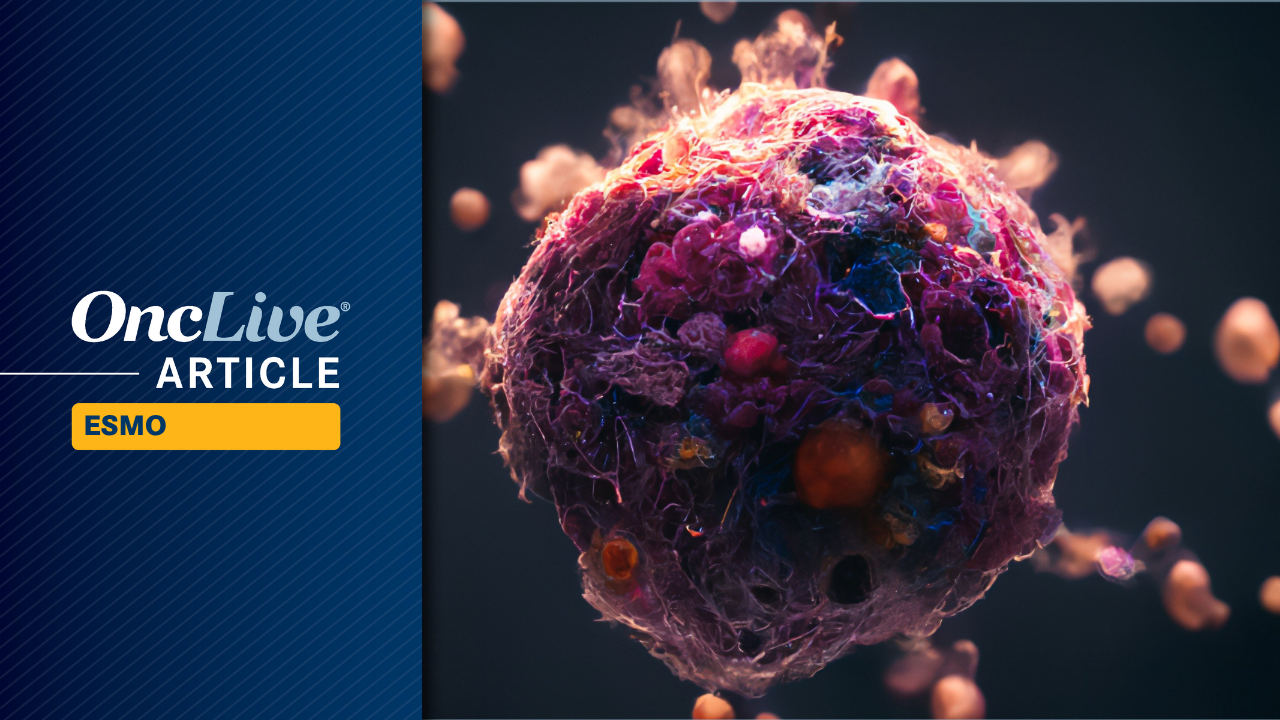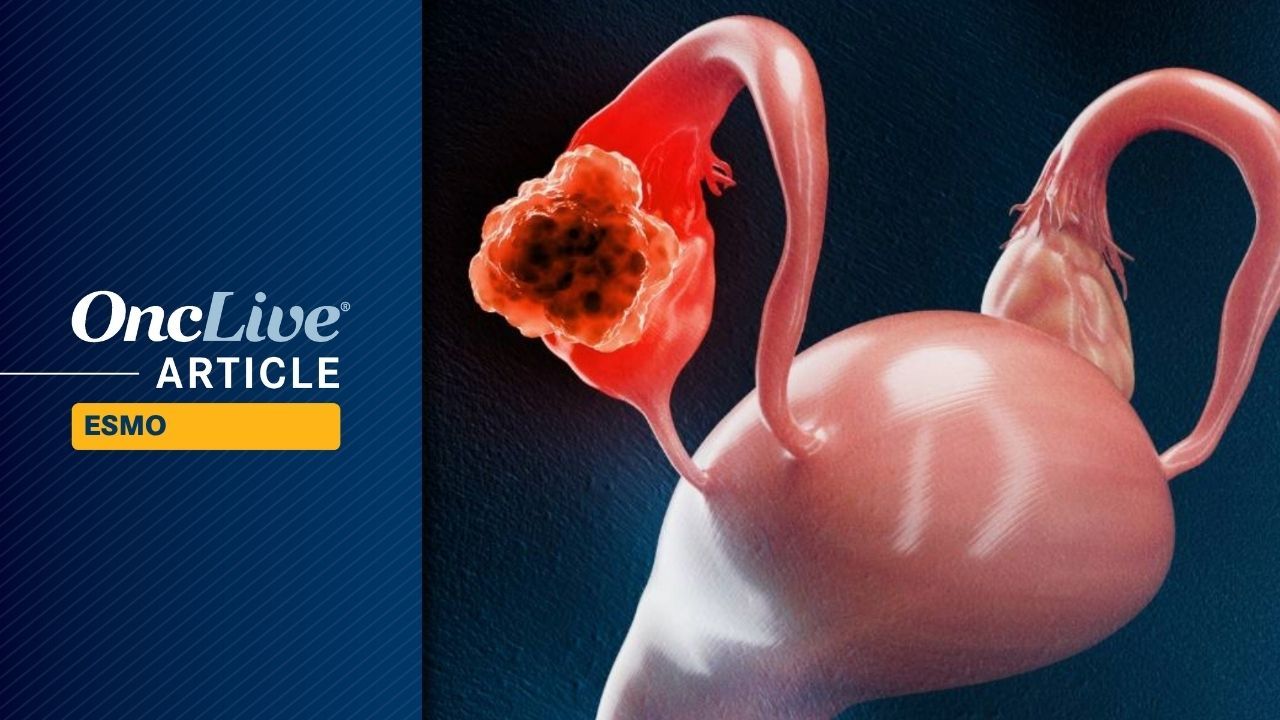Interim data from the phase 3 DESTINY-Breast05 trial (NCT04622319) shared at the 2025 European Society for Medical Oncology (ESMO) Congress showed improved invasive disease–free survival (IDFS) with fam-trastuzumab deruxtecan-nxki (T-DXd; Enhertu) gin compared with ado-trastuzumab emtansine (T-DM1; Kadcyla) in patients with high-risk, HER2-positive primary breast cancer with residual invasive disease following neoadjuvant therapy.1
Treatment with T-DXd (n = 818) led to a 53% reduction in the risk of invasive disease or death compared with T-DM1 (n = 817; HR, 0.47; 95% CI, 0.34–0.66; P < .0001). The 3-year IDFS rates were 92.4% (95% CI, 89.7%–94.4%) with T-DXd vs 83.7% (95% CI, 80.2%–86.7%) with T-DM1.
“Patients benefited [from T-DXd] irrespective of age cohorts, region of accrual, hormone receptor status, disease status at presentation, post-therapy pathologic nodal status, and dual or single HER2-targeted therapy, as well as irrespective of the sequence or usage of radiation therapy for that minority of patients who did not receive [radiation] treatment,” Charles E. Geyer Jr., MD, said in the presentation.
Geyer is a professor of medicine and chief of the Division of Malignant Hematology and Medical Oncology at the University of Pittsburgh Medical Center Hillman Cancer Center in Pennsylvania.
What Was the Rationale for DESTINY-Breast05?
Previously, the phase 3 KATHERINE trial (NCT01772472 ) showed that T-DM1 improved IDFS (HR, 0.50; 95% CI, 0.39-0.64; P < .0001) and overall survival (OS; HR, 0.66; 95% CI, 0.51-0.87; P = .0027) compared with trastuzumab in patients with HER2-positive early breast cancer with residual invasive disease after neoadjuvant therapy.2 However, patients with advanced locoregional disease or positive nodal status following neoadjuvant therapy had 3-year IDFS rates of 76% and 83%, respectively; the 7-year IDFS rates were 67% and 72%, respectively.1 These data reinforce the unmet need for improved post-neoadjuvant treatment in this population, Geyer emphasized.
What Was the Study Design?
This global, multicenter, randomized, open-label trial enrolled patients with residual invasive disease in the breast and/or axillary lymph nodes after neoadjuvant chemotherapy with a HER2-directed therapy. Patients needed to present with high-risk disease prior to neoadjuvant therapy, defined as inoperable early breast cancer or operable early breast cancer with axillary node–positive disease after neoadjuvant therapy. Patients also needed to have centrally confirmed HER2-positive disease and an ECOG performance status of 0 or 1. Enrolled patients were stratified by extent of disease at presentation (inoperable vs operable), type of HER2-targeted neoadjuvant therapy received (single vs dual), hormone receptor status (positive vs negative), and post-neoadjuvant therapy pathologic nodal status (positive vs negative).
Patients were randomly assigned 1:1 to receive intravenous (IV) T-DXd at 5.4 mg/kg every 3 weeks for 14 cycles, or IV T-DM1 at 3.6 mg/kg every 3 weeks for 14 cycles. Treatment was followed by a 40-day safety follow-up period.
Notably, concomitant adjuvant endocrine therapy was allowed per local practice protocols. Additionally, radiotherapy, if administered, could be initiated concurrently with study therapy or completed prior to the initiation of study therapy per the investigator. An interstitial lung disease (ILD) monitoring program was required for patients who received radiotherapy.
IDFS served as the primary end point, with disease-free survival (DFS) as a key secondary end point. Other secondary end points included OS, distant recurrence–free interval (DRFI), brain metastasis–free interval (BMFI), and safety.
What Did the Patient Population Look Like?
In total, 1635 patients were randomly assigned to receive T-DXd (n = 818) or T-DM1 (n = 817). In the T-DXd arm, 806 patients received treatment. A total of 27.7% of patients in this arm discontinued treatment due to adverse effects (AEs; 17.9%), patient withdrawal (7.4%), disease recurrence (0.2%), physician decision (1.9%), and protocol deviation (0.2%). In total, 72.3% of patients in this arm completed study treatment, and the median study duration was 29.9 months (range, 0.3-53.4).
In the T-DM1 arm, 801 patients received treatment. A total of 23.7% of patients in this arm discontinued treatment due to AEs (12.7%), patient withdrawal (6.2%), disease recurrence (3.7%), physician decision (0.6%), protocol deviation (0.1%), and other reasons (0.1%). In total, 76.3% of patients in this arm completed study treatment, and the median study duration was 29.7 months (range, 0.1-54.4).
In the T-DXd arm, the median age was 50.3 years (range, 24–78), Asian patients were the most predominant race (48.8%), and most patients had HER2 3+ disease by immunohistochemistry (IHC) (82.6%), hormone receptor–positive disease (71.0%), inoperable disease (52.7%), positive nodal status (80.7%), received dual HER2-targeted therapy with trastuzumab plus pertuzumab (77.9%), prior anthracycline use (51.7%), and received prior adjuvant radiotherapy (93.4%). In the T-DM1 arm, the median age was 50.6 years (range, 21-83), Asian patients were the most predominant race (47.2%), and the highest proportions of patients had HER2 3+ disease by IHC (82.0%), hormone receptor–positive disease (71.4%), inoperable disease (51.9%), positive nodal status (80.5%), received dual HER2-targeted therapy with trastuzumab plus pertuzumab (78.5%), prior anthracycline use (48.8%), and received prior adjuvant radiotherapy (92.9%).
What Additional Efficacy Outcomes Were Observed?
Overall, investigators observed lower rates of distant and local recurrences, including central nervous system (CNS) recurrences, with T-DXd vs T-DM1. The numbers of patients with recurrences in these respective arms were as follows:
- Distant recurrence: n = 42 (non-CNS, n = 25; CNS, n = 17); n = 77 (non-CNS, n = 52; CNS, n = 25)
- Local invasive recurrence: n = 1; n = 5
- Regional recurrence: n = 1; n = 6
- Contralateral invasive disease: n = 0; n = 6
- Death without prior reported event: n = 7; n = 8
A DFS benefit was observed with T-DXd vs T-DM1 (HR, 0.47; 95% CI, 0.34–0.66; P < .0001). The 3-year DFS rates were 92.3% (95% CI, 89.5%–94.3%) with T-DXd vs 83.5% (95% CI, 79.9%–86.4%) with T-DM1.
DRFI, BMFI, and OS benefits were also seen with T-DXd vs T-DM1. The respective 3-year DRFI rates were 93.9% (95% CI, 91.4%–95.7%) and 86.1% (95% CI, 82.5%–89.1%); the HR was 0.49 (95% CI, 0.34–0.71) favoring the T-DXd arm. The respective 3-year BMFI rates were 97.6% (95% CI, 96.2%–98.5%) and 95.1% (95% CI, 93.6%–97.2%); the HR was 0.64 (95% CI, 0.35–1.17) favoring the T-DXd arm. The respective 3-year OS rates were 97.4% (95% CI, 95.8%–98.4%) and 95.7% (95% CI, 93.5%–97.2%); the HR was 0.61 (95% CI, 0.34–1.10) favoring the T-DXd arm.
Regarding on-study treatment exposure, in the T-DXd arm, the median study treatment duration was 9.8 months, and 72.3% of patients completed the planned 14 cycles of therapy. In the T-DM1 arm, the median study treatment duration was 9.7 months, and 76.3% of patients completed the planned 14 cycles of therapy. Notably, patients who discontinued the study before receiving 14 cycles of study treatment were permitted to receive an additional HER2-targeted therapy per standard of care (SOC) guidelines to complete 14 total cycles of HER2-targeted adjuvant therapy.
What Was the Safety Profile?
In the T-DXd arm, any-grade treatment-emergent AEs (TEAEs) were reported in 99.5% of patients, and 50.6% of patients experienced grade 3 or higher TEAEs. Serious TEAEs (17.4%) and those associated with drug discontinuation (17.9%; drug-related ILD/pneumonitis, 10.8%), drug interruptions (49.6%), dose reductions (26.4%), and deaths (0.4%; ILD/pneumonitis, n = 2; respiratory tract infection adjudicated as not ILD, n = 1) also occurred.
In the T-DM1 arm, any-grade TEAEs were reported in 98.4% of patients, and 51.9% of patients experienced grade 3 or higher TEAEs. Serious TEAEs (13.6%) and those associated with drug discontinuation (12.9%; drug-related ILD/pneumonitis, 2.5%), drug interruptions (41.1%), dose reductions (26.6%), and deaths (0.6%; leiomyosarcoma of the uterus, aneurysm, non-neutropenic sepsis, ovarian cancer, and traumatic pneumothorax, n = 1 each) also occurred.
The most commonly reported TEAEs in the T-DXd and T-DM1 arms, respectively, were nausea (71.3%; 29.3%), constipation (32.0%; 16.2%), decreased neutrophil counts (31.6%; 14.4%), vomiting (31.0%; 9.0%), decreased white blood cell counts (29.7%; 13.0%), fatigue (29.5%; 20.2%), radiation pneumonitis (28.8%; 27.0%), anemia (28.3%; 17.0%), increased aspartate aminotransferase levels (25.6%; 50.2%), increased alanine aminotransferase levels (23.7%; 45.3%), diarrhea (23.2%; 8.6%), decreased platelet counts (21.2%; 49.8%), decreased appetite (20.0%; 10.0%), headache (15.8%; 20.7%), and arthralgia (10.3%; 20.5%).
The rates of adjudicated drug-related ILD in the T-DXd and T-DM1 arms were as follows:
- Any-grade: 9.6% vs 1.6%
- Grade 1: 2.0% vs 1.0%
- Grade 2: 6.5% vs 0.6%
- Grade 3: 0.9% vs 0%
- Grade 4: 0% vs 0%
- Grade 5: 0.2% vs 0%
No differences in adjudicated drug-related ILD instances were observed based on adjuvant radiotherapy timing (sequential or concurrent). Investigators observed similar distributions of any-grade adjudicated drug-related ILD events with sequential (T-DXd arm, 10.7%; T-DM1 arm, 2.6%) and concurrent (9.6%; 1.0%) radiotherapy.
The rates of left ventricular dysfunction in the T-DXd and T-DM1 arms were as follows:
- Any-grade: 2.9% vs 1.7%
- Grade 1: 0.1% vs 0%
- Grade 2: 2.5% vs 1.4%
- Grade 3: 0.2% vs 0.4%
- Grade 4: 0% vs 0%
- Grade 5: 0% vs 0%
“Adjuvant T-DXd demonstrated superior efficacy with manageable safety in patients with high-risk, HER2-positive early breast cancer and residual invasive disease after neoadjuvant therapy, which represents a potential new SOC in this post-neoadjuvant setting,” Geyer concluded.
DISCLOSURES: Geyer reported receiving grants from or having contracts with Daiichi Sankyo, AstraZeneca, Roche/Genentech, and Exact Sciences; receiving meeting and/or travel support from Exact Sciences; receiving honoraria or travel expenses from Exact Sciences and Merck; and receiving support for the current presentation from Daiichi Sankyo and AstraZeneca.









